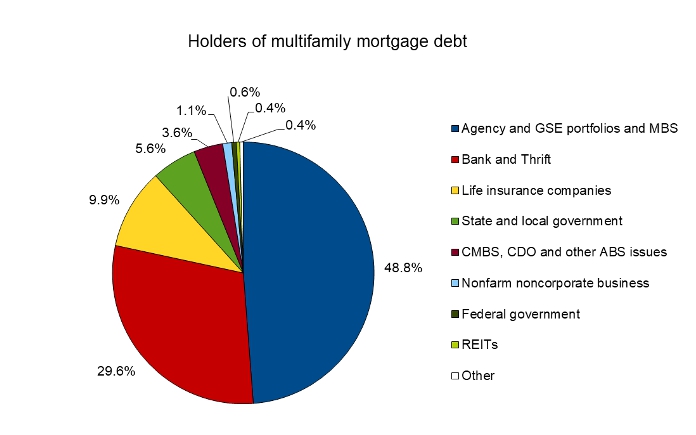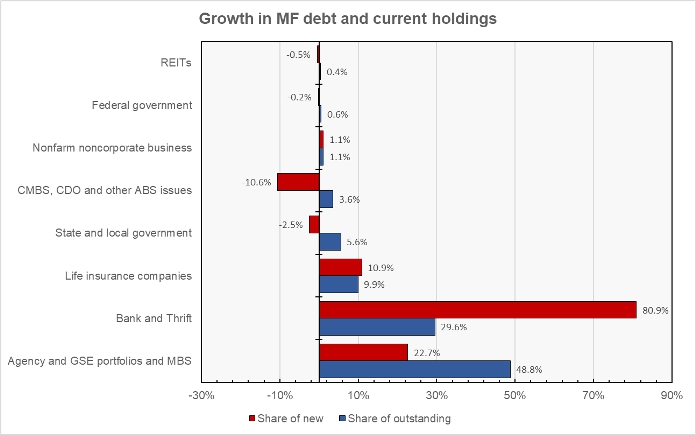A Mortgage Bankers Association (MBA) report on commercial and multifamily mortgage debt holdings in Q2 2022 shows that banks and thrifts had the largest net increase in multifamily mortgage holdings for the third quarter in a row. However, many categories of smaller lenders reduced their holdings of multifamily mortgages during the quarter.
The MBA reported that multifamily mortgage debt outstanding rose by $35.7 billion in Q2, a slightly lower increase than in Q1. Total multifamily mortgages outstanding reached a level of $1.883 trillion. Compared to the year-earlier level, debt was up $142 billion (8.2 percent).
The total of all commercial mortgage debt, including multifamily debt, outstanding at the end of Q2 rose 2.3 percent from its Q1 2022 level to $4.380 trillion. Multifamily mortgage debt represented 43.0 percent of commercial mortgage debt outstanding.
In an earlier report, the MBA said that multifamily mortgage originations had increased in Q2, with the Q2 2022 multifamily mortgage originations index reported to be up 24 percent from the level of the index in Q2 2021. By contrast, the increase in multifamily mortgage debt outstanding in Q2 2022 was only 14.7 percent larger than the increase in Q2 2021. So, while mortgage originations increased year-over-year, mortgage redemptions reduced the net increase in multifamily mortgages outstanding.
Assessing the players
The shares of multifamily mortgage debt held by various classes of suppliers are shown in the first chart, below.

Of the increase in multifamily mortgage debt outstanding in the quarter, $8.0 billion, was held by “Agency and GSE portfolios and MBS”. These are agencies, like the Federal Housing Administration and Government Sponsored Enterprises (GSEs) like Fannie Mae and Freddie Mac, who buy up mortgages and sell some of the debt as Mortgage-Backed Securities (MBS). At the end of Q2, the GSEs holdings of multifamily mortgages fell to 48.8 percent of the total outstanding. The GSEs’ share of this debt has been trending lower since Q1 2021.
Banks and Thrifts, the second largest holders of multifamily mortgages, increased their multifamily mortgage holdings by $28.5 billion in Q2. This represented 81 percent of the increase in multifamily mortgage debt outstanding. While this figure seems improbably high, it is partially attributable to many of suppliers of multifamily mortgages significantly decreasing their holdings during the quarter. Banks and thrifts increased their share of multifamily mortgages outstanding to 29.6 percent in Q2.
Life Insurance companies increased their direct holdings of multifamily mortgages by $3.85 billion in the quarter, raising their holdings to $187.3 billion. However, this figure does not account for the multifamily mortgage debt these companies hold through commercial mortgage-backed securities (CMBS). Life insurance companies’ share of total multifamily mortgages outstanding remained unchanged at 9.9 percent in the quarter.
While the three largest categories of lenders listed above increased their holdings of debt in Q2, 7 of the 9 other categories of lenders identified in the report reduced their holdings.
State and local governments held 5.6 percent of outstanding multifamily mortgage debt at the end of Q2. They reduced their holdings by $876 million to a total of $104.6 billion at the end of the quarter.
CMBS, CDO (collateralized debt obligations) and other ABS (asset backed securities) issuers decreased their holdings of multifamily mortgage debt in Q2 by $3.7 billion. Their share of multifamily mortgages outstanding fell to 3.6 percent.
Who’s growing their share?
The next chart, below, plots the current share of multifamily mortgage debt outstanding for a given class of lender alongside that class of lender’s share of net new mortgage debt outstanding in Q2. When the latter share is greater than the former, that class of lender is increasing its share of the multifamily mortgage market.

The chart shows that growth in holdings of banks, who were once the largest holders of multifamily mortgages, was a much greater share of the overall growth in debt outstanding than the banks’ current share of that debt. By contrast, the GSEs, who came to dominate multifamily lending after the housing crash in 2007, increased their net holdings at less than half the rate of their current holdings, reducing their share of the mortgage debt outstanding.
While the CMBS, CDO and other ABS had been aggressively increasing their holdings of multifamily mortgage debt over the last three quarters, they became net sellers in Q2. Their reduction in debt holdings was more than 10 percent of the net growth in debt outstanding.
The report does not cover loans for acquisition, development or construction, or loans collateralized by owner-occupied commercial properties. The full report also includes information on mortgage debt outstanding for other commercial property types. The report can be found here.










